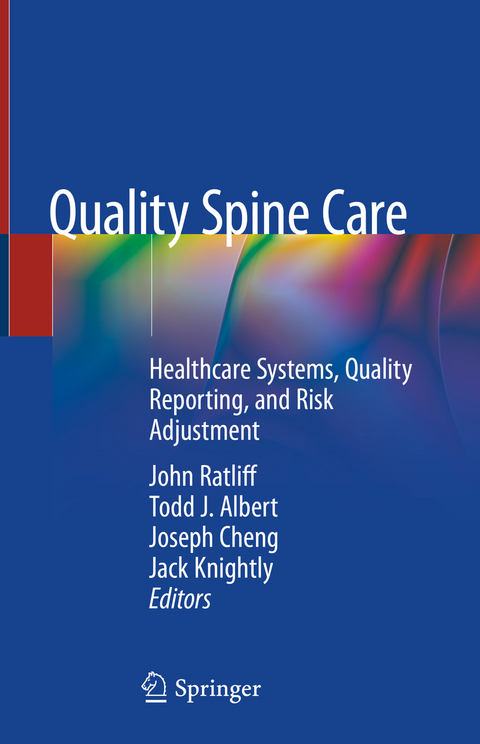
Quality Spine Care
Springer International Publishing (Verlag)
978-3-319-97989-2 (ISBN)
Quality measurement and quality reporting are ever growing aspects of the healthcare environment. Quality assessment is valuable to all healthcare stakeholders: patients, physicians, facilities, and payers. Patients are drawn to facilities that provide high value care; public reporting systems and grading systems for hospitals offer one opinion with regard to "high quality care." Most physicians email inboxes are inundated with offers of recognition for being a "Top Doc" for a nominal fee. Some payers offer incentives to patients who chose to be treated at "Centers of Excellence" or similar facilities; the definition of "Excellence" may be unclear.
There is little consensus on how to measure quality, how to incorporate patient and procedure factors and achieve accurate risk adjustment, and how to define value of care. Regardless of these challenges, regulatory efforts in the US, as well as numerous international efforts, make quality assessment and quality reporting an important part of physician behaviour.
Physician and facility reimbursement for procedures are often tied to quality metrics. Spine procedures are costly, elective, and are a focus of many payer-based programs. Hence, spine care is often a focus of quality reporting efforts. This text summarizes the state of the art with regard to quality measurement, reporting, and value assessment in spine care. We will review quality reporting in the US and internationally. Chapters will outline how quality improvement efforts have achieved success in hospital systems. The reader will be provided with insights in how to achieve success incorporating quality metrics into spine care.
Features:
1. Illustrates the state of the art in spine quality reporting: There is no text that thoroughly addresses quality assessment and quality reporting in spine care; there are, however, numerous articles in this space. This book provides a definitive text covering the state of the art for quality reporting in spine care and will be of value to the international orthopedic and neurosurgical spine community.
2. Provides insight on quality reporting in different healthcare systems: The text will allow for comparison of different quality reporting systems from different health care systems. This will provide practitioners with insight into the strengths and weaknesses of different approaches to quality reporting, and may drive improvement in quality assessment and reporting systems. A single text that features review of US, European, and Australia/Asian health care systems' quality reporting is novel and will be thought provoking for readers.
3. Describes the US and international Healthcare reimbursement systems: Practicing physicians are provided with little information and less insight into the vagaries of the US and other healthcare systems. The text will provide insight into code development, valuation, and how quality reporting affects physician reimbursement
4. Explains risk adjustment: Appropriate risk adjustment and assessing patient and procedure factors that may impact quality reporting are invalua
John RatliffDepartment of NeurosurgeryStanford UniversityStanford, CAUSA Todd J. AlbertHospital for Special SurgeryNew York, NYUSA Joseph ChengDepartment of NeurosurgeryUniversity of Cincinnati College of MedicineCincinnati, OHUSA John KnightlyNeurosurgery, Atlantic Neurosurgical SpecialistsMorristown, NJUSA
Historical Aspects of Quality in Healthcare.- Quality and Standardization of Medical Education.- The History of Quality Assessment in Spine Care.- Choice of Quality Metrics for Assessment of the Spine Patient.- Patient Reported Outcomes.- Registries in Spine Care, United States.- Registries in Spine Care, UK and Europe.- Concepts of Risk Stratification in Measurement and Delivery of Quality.- Risk Adjustment Methodologies.- Healthcare Systems in the United States.- The National Health Service (NHS) in England: Trying to Achieve Value Based Health Care.- Quality Spine Care in Australasia.- Healthcare Systems: India.- Healthcare Systems and Quality Assessment of Spine Care in Japan.- Overview of Healthcare System in China.- Conditions of Care and Episode Groups.- Aligning Healthcare Systems.- Building Quality Metrics into a Practice.- Impact of Quality Assessment on Clinical Practice, Intermountain Healthcare.- Impact of Quality Assessment on Clinical Practice, Kaiser Permanente.- How Quality is Assessed in Insurance Markets.- Centers of Excellence and Payer Defined Quality Assessment.- Reporting Quality Results.- Achieving Success in Quality Reporting.
"The text appears intended for practicing neurosurgeons and orthopedic surgeons specializing in spine surgery, as well as clinical practitioners, hospital administrators, and other individuals directly involved in the care of patients with spinal disorders. ... 'Quality Spine Care: Healthcare Systems, Quality Reporting, and Risk Adjustment' is very well written. Its concise chapters will aid any spine surgeon in optimizing one's practice to focus on quality and value." (Scott J. Raffa and Michael Y. Wang, Neurosurgery, Vol. 85 (4), October, 2019)
"The audience is practitioners, surgeons, public health specialists, and even healthcare administrators. The book meets the objective of addressing these audiences and is relatively straightforward in its explanations. ... This is a high-quality book that provides a great recapitulation of quality assessment in spine care. It is thefirst book its kind and is a great focused review of this topic." (Ankit I Mehta, Doody's Book Reviews, July 05, 2019)
| Erscheinungsdatum | 11.11.2018 |
|---|---|
| Zusatzinfo | XXI, 405 p. 45 illus., 44 illus. in color. |
| Verlagsort | Cham |
| Sprache | englisch |
| Maße | 155 x 235 mm |
| Gewicht | 990 g |
| Themenwelt | Medizinische Fachgebiete ► Chirurgie ► Neurochirurgie |
| Medizinische Fachgebiete ► Chirurgie ► Unfallchirurgie / Orthopädie | |
| Schlagworte | Episode Groups • Quality Metrics • Registries in Spine Care • Reporting of Quality • Risk stratification |
| ISBN-10 | 3-319-97989-2 / 3319979892 |
| ISBN-13 | 978-3-319-97989-2 / 9783319979892 |
| Zustand | Neuware |
| Informationen gemäß Produktsicherheitsverordnung (GPSR) | |
| Haben Sie eine Frage zum Produkt? |
aus dem Bereich


